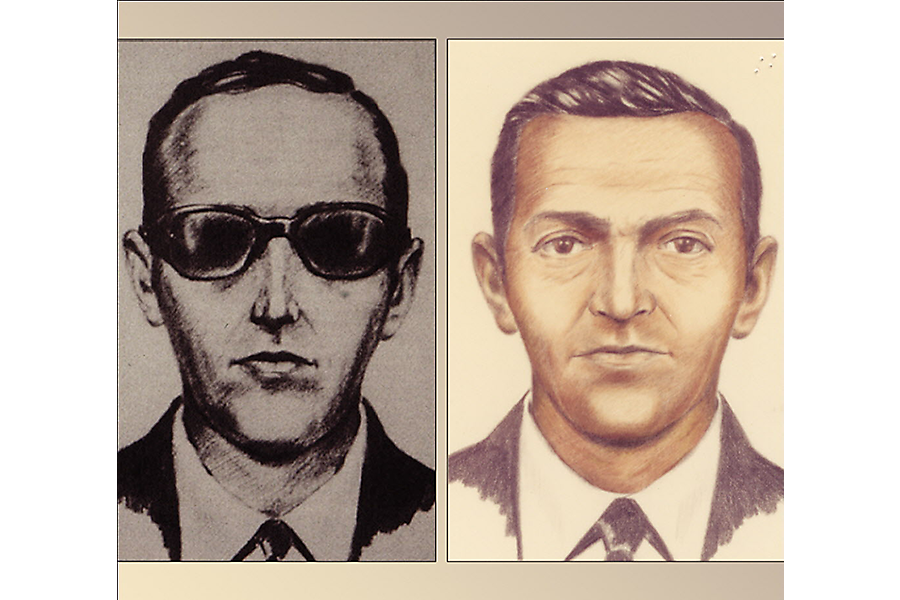Could new 'clip-on' evidence help crack the D.B. Cooper case?
Loading...
Leave it to a group that calls itself the Citizen Sleuths to uncover a new lead in the 45-year hunt for D.B. Cooper.
The three amateur scientists have found rare-Earth elements on the JCPenney tie the infamous skyjacker left behind when he jumped out of a commercial airplane on a blistering night in 1971, with $200,000 in unmarked bills, a parachute, and a raincoat. The sleuths say the elements could indicate Cooper was an engineer or manager in the aerospace industry.
The FBI closed its investigation in July, calling it one of the longest and most exhaustive in the agency’s history. Perhaps the biggest break in the case came in 1980 when an 8-year-old boy, while searching for firewood, found a bundle of $20 bills from the hijacking along the Columbia River near Vancouver, Wash.
While that find seemed to support the theory Cooper didn’t survive the jump into the freezing rain and pitch-black sky, this latest discovery could help unravel the mystery behind the true identity of the man who called himself Dan Cooper.
"The fascination with Cooper has survived not because of the FBI investigation, but because he was able to do something that not only captured the public imagination, but also maintained a sense of mystery in the world," Geoffrey Gray, author of “Skyjack: The Hunt for D.B. Cooper,” told the Associated Press.
Whether the scientists add to Cooper’s lore, or diminish the mystery, they say the clip-on tie Cooper left on the Boeing 727 tell us a lot about him. The amateur scientists, which include a paleontologist from Seattle’s Burke Museum, found more than 1,000 particles on the tie when they had it examined under an electron microscope. Among them were the cerium, strontium sulfide, and pure titanium.
Tom Kaye, the paleontologist and the lead researcher for the group, told CBS affiliate King5 on Friday that the chemicals were used in the aerospace industry in 1971. Boeing, said Mr. Kaye, was using these chemicals in its efforts to build a Super Sonic Transport Plane, which it was developing with government funding in the 1960s and 1970s. Boeing historically had a large factory in Everett, Wash., near Seattle.
Kaye told King5 the discovery indicates Cooper could have been a Boeing employee or a contractor.
“The tie went with him into these manufacturing environments, for sure, so he was not one of the people running these [manufacturing machines]. He was either an engineer or a manager in one of the plants,” Kaye said.
The scientists are posting a running list of the particles they have found on Cooper’s tie, with the hope others will come forward with more knowledge about how these particles were used then or, perhaps, with the true identity of Cooper.
On Nov. 24, 1971, the day before Thanksgiving, a man who called himself Dan Cooper (early wire-service reports misidentified him as “D.B. Cooper”) bought a $20 ticket at Portland International Airport for a Northwest Orient flight bound for Sea-Tac in Seattle. The man, who fellow passengers later described as slim, olive-skinned, and wearing a black suit and aviator sunglasses, coolly ordered a bourbon and soda and smoked a cigarette aboard the plane before he handed a stewardess a note that read in all capital letters: I HAVE A BOMB IN MY BRIEFCASE. I WILL USE IT IF NECESSARY. I WANT YOU TO SIT NEXT TO ME. YOU ARE BEING HIJACKED."
When the stewardess slipped the note, unread, into her pocket, the man said, "Miss, you'd better look at that note. I have a bomb."
The plane landed as scheduled in Seattle, where the hijacker managed to get $200,000 and a parachute in ransom for the passengers. He then ordered the pilots to take off and head for Mexico.
En route somewhere over the woods of Washington and Oregon, a cockpit warning light showed the rear door of the plane had been opened. The pilots asked over the intercom, “Is everything OK back there?”
“No!” the man yelled, and jumped.
Since then, the biggest break in the case came in 1980 with the discovery of the unmarked bills. Other than that, a body was never found, leading to a slew of conspiracy theories, books, and songs. A Michigan author proposed Cooper was in fact a father of four, Richard Lepsy, who went missing from Grayling, Michigan in 1969. An Oklahoma woman also told the FBI about a late uncle who showed up to Thanksgiving dinner in Oregon in 1971 with serious injuries. The FBI couldn’t conclusively link guitar straps made by the uncle, L.D. Cooper, with evidence found on the clip-on tie. The History Channel also recently suggested a 72-year-old California man, Robert W. Rackstraw, may have been Cooper, although the Vietnam veteran’s former lawyer denied the documentary’s allegations.
"Americans like their criminals suave and sophisticated, and this guy fits the bill," Stephen Mihm, a folklore expert at the University of Georgia in Athens, told the Christian Science Monitor’s Patrik Jonsson, about Cooper. "There's something very debonaire about the nature of the hijacking, and it was extremely risky, too, and that combination … is probably more appealing than if he he looked like a Hell's Angel and killed several people along the way. He fits our ideal of a criminal mastermind."
This report contains material from the Associated Press.
[Editor's note: An earlier version suggested that strontium sulfide was an element. It is, of course, a compound composed of two elements.]







